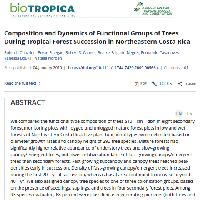Resumen
- We compared the functional type composition of trees ≥10 cm dbh in eight secondary forest monitoring plots with logged and unlogged mature forest plots in lowland wet forests of Northeastern Costa Rica. Five plant functional types were delimited based on diameter growth rates and canopy height of 293 tree species. Mature forests had significantly higher relative abundance of understory trees and slow-growing canopy/emergent trees, but lower relative abundance of fast-growing canopy/emergent trees than secondary forests. Fast-growing subcanopy and canopy trees reached peak densities early in succession. Density of fast-growing canopy/emergent trees increased during the first 20 yr of succession, whereas basal area continued to increase beyond 40 yr. We also assigned canopy tree species to one of three colonization groups, based on the presence of seedlings, saplings, and trees in four secondary forest plots. Among 93 species evaluated, 68 percent were classified as regenerating pioneers (both trees and regeneration present), whereas only 6 percent were classified as nonregenerating pioneers (trees only) and 26 percent as forest colonizers (regeneration only). Slow-growing trees composed 72 percent of the seedling and sapling regeneration for forest colonizers, whereas fast-growing trees composed 63 percent of the seedlings and saplings of regenerating pioneers. Tree stature and growth rates capture much of the functional variation that appears to drive successional dynamics. Results further suggest strong linkages between functional types defined based on adult height and growth rates of large trees and abundance of seedling and sapling regeneration during secondary succession.
